Research activities
Hayabusa
and
Itokawa

Hayabusa Mission
Asteroids are considered as primitive solar system celestial bodies that retain information since the solar system was born. Detailed analyses of samples collected on the surface of asteroid and brought back to Earth will provide invaluable clues to the origin and evolution of the solar system. Return of sample from a solar system object is called "sample return". The Hayabusa was the spacecraft (planetary probe) to develop the technologies necessary to achieve a full-scale sample return mission in the future and to demonstrate them whether they can be used in practice.
Objectives

Science instruments onboard Hayabusa
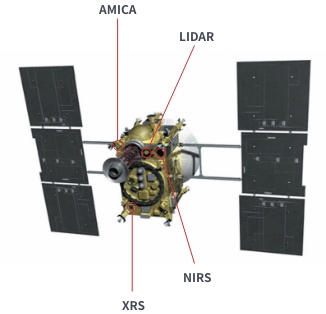
-
 AMICA (Asteroid Multiband Imaging CAmera)
AMICA (Asteroid Multiband Imaging CAmera)Equipped with a 7-band color filter and polarizer to acquire color information of the asteroid. The mineral composition distribution and shape of the Itokawa surface are examined by discriminating the slight color difference of the asteroid surface layer.
-
 LIDAR (LIght Detection And Ranging)
LIDAR (LIght Detection And Ranging)A laser pulse is used to measure the distance between a probe and an asteroid. The LIDAR is a very important navigation sensor for the Hayabusa that approaches and lands on Itokawa. It also performs surface profile measurement and gravity measurement using the rotation of Itokawa.
-
 NIRS (Near InfraRed Spectrometer)
NIRS (Near InfraRed Spectrometer)This device spectrally separates the light reflected by sunlight on the surface of Itokawa. Spectroscopy is the study of the intensity (asteroid surface color) of light at different wavelengths by breaking it down into individual wavelengths. By studying the wavelength of the asteroid surface, it is possible to understand the types of minerals and surface conditions on the Itokawa surface.
-
 XRS (X-Ray Spectrometer)
XRS (X-Ray Spectrometer)This instrument is used to determine major elemental composition (magnesium, aluminum, silicon, sulfur, calcium, titanium, iron, etc.) on the surface of asteroids. When solar X-rays irradiate the surface of asteroid, atoms in surface rocks are excited by photoelectric absorption, and part of the energy is emitted as X-rays (fluorescent X-ray). X-ray fluorescence has an energy specific of element. Asteroids faintly emit with fluorescent X-rays, and their elemental composition can be determined by observing energy spectra.
History
| May 9th, 2003 | Launched by a M-V rocket. |
|---|---|
| May, 2004 | Accelerated by Earth swing-by. |
| Sep 12th, 2005 | Arrived at Itokawa after two billion km journey.Observed the shape, geomorphology, topography, reflectivity, mineralogy, gravity and major elemental composition of Itokawa from an altitude of 3 to 20 km. |
| Nov 20th, 2005 | The 1st touch-down, collected samples from Itokawa surface. |
| Nov 25th, 2005 | The 2nd touch-down, collected samples from Itokawa surface. Departed from Itokawa. |
| Apr, 2007 | Changed orbit for return to Earth |
| Jun 13th, 2010 | Reentered the re-entry capsule into the Earth. Retrieved the capsule in Woomera, Australia. |
Sample Collection
The sample catcher of Hayabusa is divided into 3 sections, that is, the A chamber, the B chamber and the rotary cylinder. By rotating the movable part of the rotary cylinder, the collected sample can be divided into A and B chambers. Hayabusa touched down at two different sites of "Muses Sea", and the sample collected during the 1st touchdown was stored in room B, and the sample collected during the 2nd touchdown were stored in room A.
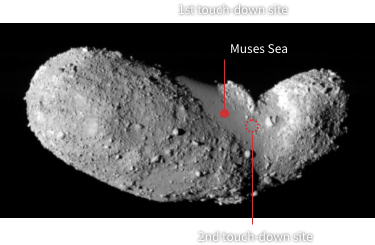
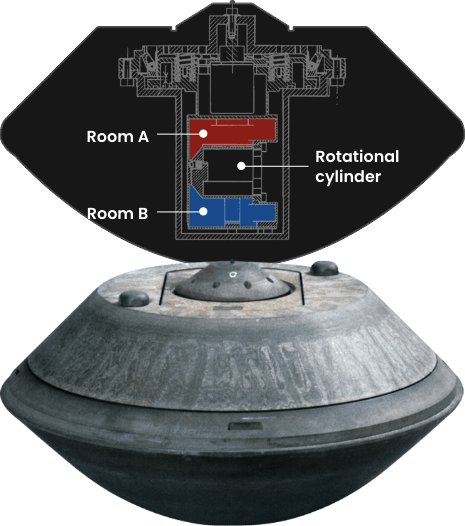
Scientific Results from Itokawa Return Sample
A portion of the sample was provided for the Initial Analysis team. Results of this research have been published in a special issue of the U.S. scientific journal "Science".

NAKAMURA Tomoki (Tohoku Univ.) et al.
Evidence for a direct link between S-type asteroids and ordinary chondrite meteorites: Detailed mineralogical studies have shown that the asteroid Itokawa is composed of materials similar to LL4-LL6 chondrite meteorites. At the same time, important knowledge on the origin and formation process of Itokawa was obtained. The size of Itokawa's parent body is thought to be more than 10 times larger than the present one, and the temperature of the central part is thought to have risen to about 800 °C and then cooled slowly. After that time, a huge impact collision occurred, and the Itokawa might have been formed by reaccumulation of impact fragments.
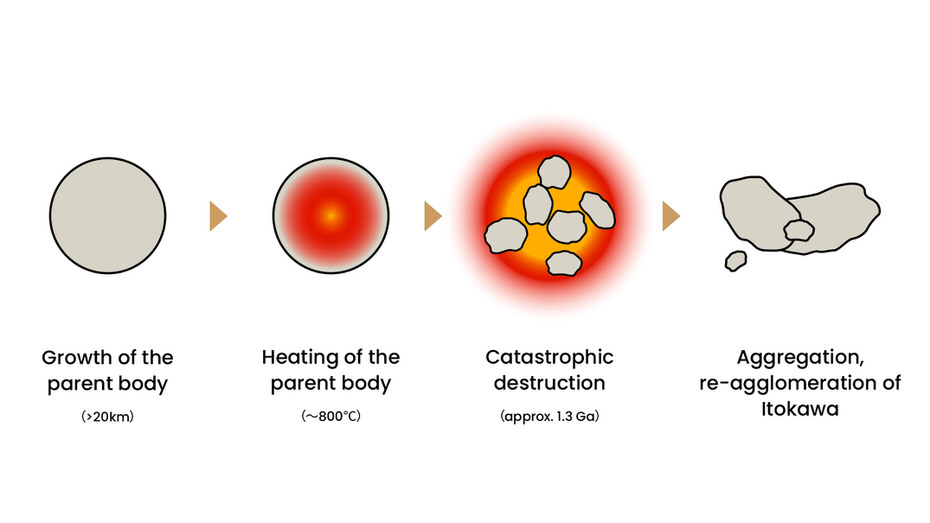
YURIMOTO Hisayoshi (Hokkaido Univ.) et al.
Oxygen isotopic composition analysis of Itokawa particulate samples revealed their isotopic ratios different from terrestrial standards, and proved that they were extraterrestrial origin. This analysis provides evidence that S-type asteroid Itokawa should be among the sources of the LL or L group of equilibrium ordinary chondrites, the types of meteorites falling to Earth.
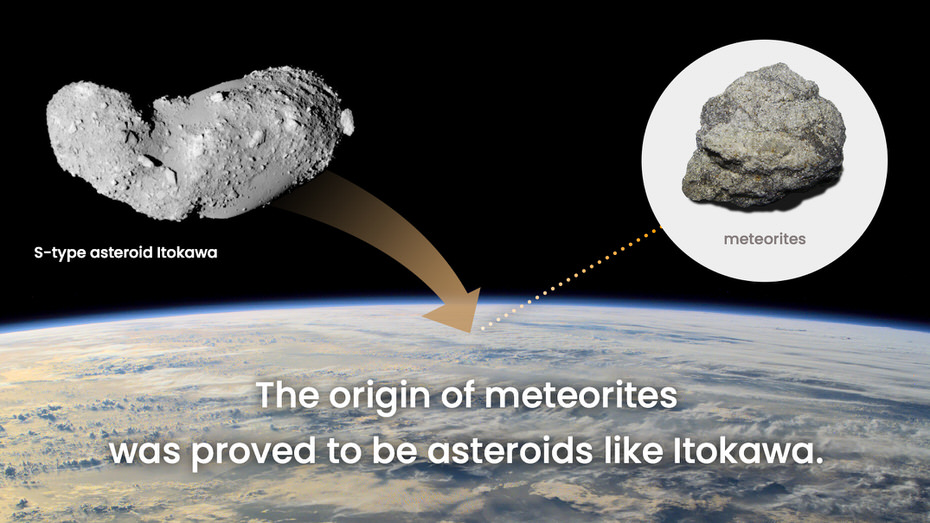
EBIHARA Mitsuru (Tokyo Metropolitan Univ.) et al.
Neutron activation analysis determined the abundance of important elements, and indicated the evidence of elemental fractionation process which occurred in the early solar system.

TUCHIYAMA Akira (Osaka Univ.) et al.
X-ray micro-CT analysis of the particle samples showed their three-dimensional shapes characteristic of asteroid regolith particle under a micro-gravity condition, indicating the origin and evolution of the regolith particles and suggesting the similarity to LL5 or LL6 chondrites due to the internal structure and the ratio of constituent minerals.

NOGUCHI Takaaki (Ibaraki Univ.) et al.
Detailed observation very close to the surface of particulate samples with a special electron microscope discovered the existence of iron-rich ultrafine particles containing unique elements which should have been produced by space weathering. This is a direct evidence of space weathering which shows LL chondrites have S-type spectra when subjected to space weathering.

NAGAO Keisuke (Tokyo Univ.) et al.
Analysis of noble gas (Helium, Neon and Argon which is originated from the solar wind and now contained in fine particles proved that these fine particle samples originated from the surface layer of Itokawa. The period of time that the particles are exposed to the solar wind is between 100 and 1,000 years. On the other hand, since the effect of high-energy galactic cosmic ray irradiation is below the detection limit, the materials of Itokawa surface layer were getting lost to outer space at a rate of several tens of centimeters depth or more in 1 million years.
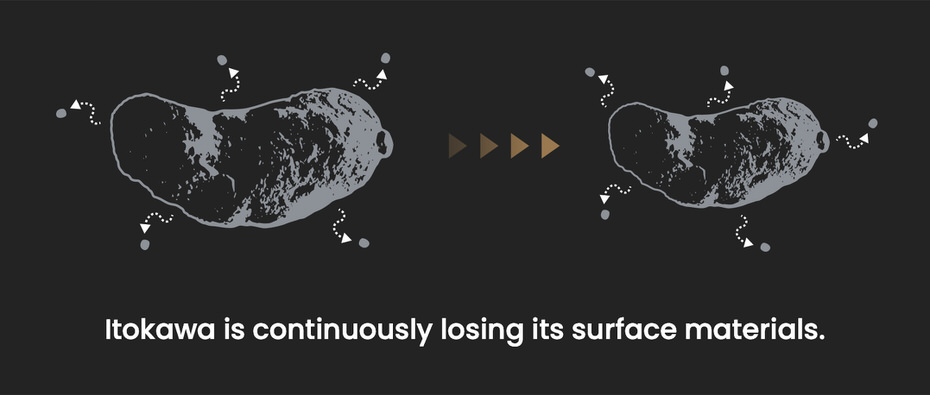
The Extraterrestrial Sample Curation Center (ESCuC) manages the particles that the spacecraft Hayabusa brought back from the asteroid Itokawa.
Research activities
Research activities
- TOP
- Hayabusa and Itokawa












